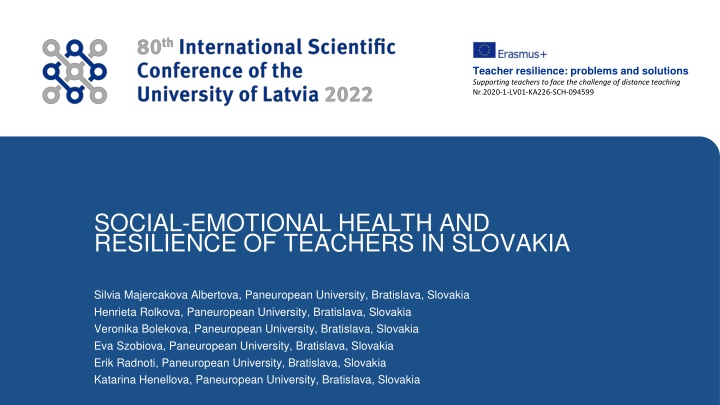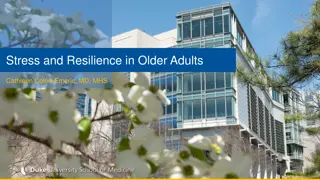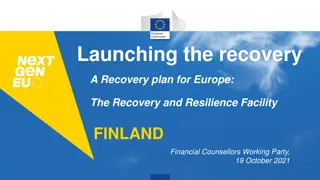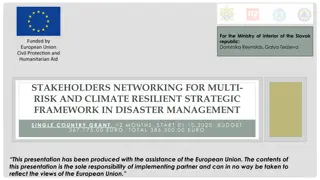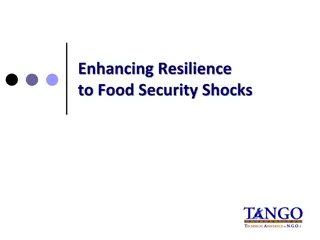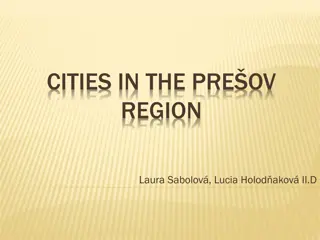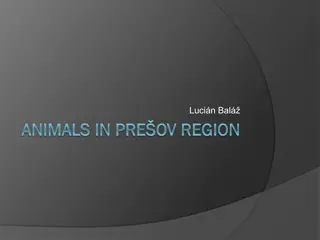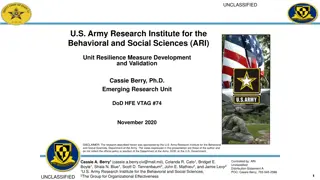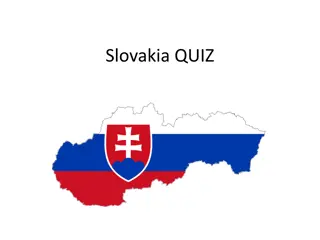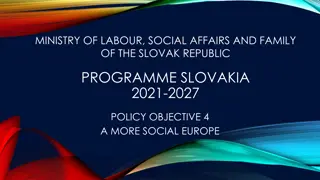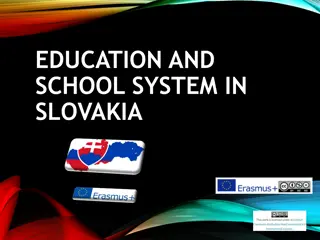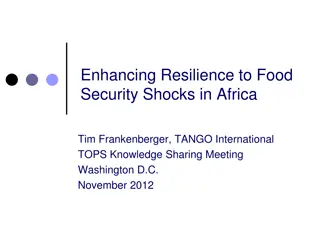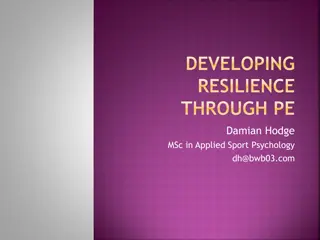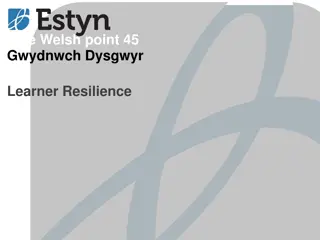Supporting Teacher Resilience in Slovakia: Challenges and Solutions
Teachers in Slovakia face various challenges in distance teaching, impacting their social-emotional health and resilience. This research project aims to explore the demanding nature of the teaching profession, common stressors affecting teachers' mental health, and the importance of social-emotional wellbeing in predicting overall teacher wellbeing. Strategies to support teacher resilience are crucial in mitigating the impact of these challenges.
Download Presentation

Please find below an Image/Link to download the presentation.
The content on the website is provided AS IS for your information and personal use only. It may not be sold, licensed, or shared on other websites without obtaining consent from the author.If you encounter any issues during the download, it is possible that the publisher has removed the file from their server.
You are allowed to download the files provided on this website for personal or commercial use, subject to the condition that they are used lawfully. All files are the property of their respective owners.
The content on the website is provided AS IS for your information and personal use only. It may not be sold, licensed, or shared on other websites without obtaining consent from the author.
E N D
Presentation Transcript
Teacher resilience: problems and solutions Supportingteachers to face the challenge of distance teaching Nr.2020-1-LV01-KA226-SCH-094599 SOCIAL-EMOTIONAL HEALTH AND RESILIENCE OF TEACHERS IN SLOVAKIA Silvia Majercakova Albertova, Paneuropean University, Bratislava, Slovakia Henrieta Rolkova, Paneuropean University, Bratislava, Slovakia Veronika Bolekova, Paneuropean University, Bratislava, Slovakia Eva Szobiova, Paneuropean University, Bratislava, Slovakia Erik Radnoti, Paneuropean University, Bratislava, Slovakia Katarina Henellova, Paneuropean University, Bratislava, Slovakia
Research Project Research conducted as part of Erasmus+ Project 2020-1-LV01-KA226- SCH-094599-PA Supporting teachers to face the challenge of distance teaching Slovakia Latvia Lithuania 2
Profession of Teacher Teacher profession is very demanding in terms of workload since requirements placed upon teacher personality are very high (Paul k, 2017) Requirements for a good teacher which include professional and social competence, qualification, personal maturity and resilience (Black & Howard-Jones, 2000; Paul k, 2017) Teacher as an organizing agent in school is responsible for course and result of educational process (Urb nek, 2008) 3
Teachers and Mental Health Most common reasons associated with teacher stress are: excessive administrative burden, excessive workload lack of free time, insufficient school facilities, unhealthy interpersonal relationships with colleagues, school management and students, Insufficient support from school management constant expectations placed upon quality work performance (Zelina, 1997, Paul k, 2017, Van ov , 2017) Impact of the pandemic? Challenges of distance learning? 4
Social-Emotional Health Cummulation of several positive social and emotional individual strengths that contribute to social-emotional wellbeing covitality = co-occurrence of several positive strengths synergistic effect of positive mental health resulting from the interplay among multiple positive psychological building blocks (Renshaw et al., 2014, p. 14) shown to be more effective in predicting wellbeing than the presence of a single positive trait alone (Furlong et al, 2014; Renshaw et al., 2014) 5
Social-Emotional Health System Social-Emotional Health Survey Primary SEHS-P, Furlong et al., 2013 Social-Emotional Health Survey Secondary SEHS-S, Furlong et al., 2014 Social-Emotional Health Survey Higher Education SEHS-S, Furlong et al., 2016 Social-Emotional Health Survey Teachers SEHS-T, Furlong & Gajdo ov , 2017 6
Social-Emotional Health - Teachers COVITALITY Emotional Competence Engaged Living Belief-in- Others Belief-in-Self Cognitive Reappraisal Self- Family Support Optimism Awareness Self- Colleague Support Gratitude Self-Efficacy Regulation Institutional Support Empathy Zest Persistence (Social-Emotional Health - Teachers. Furlong & Gajdo ov , 2017) 7
Resilience Personality characteristic that moderates negative effects of stress and promotes adaptation (Wagnild, Young, 1993, s. 165) Promotes optimal development of individual in the context of past and present adversity Enables coping with difficult life situations and adverse circumstances over the lifespan Complex disposition that enables development of competences in adverse life circumstances (Szobiov et al., 2015) 8
Aim of the Study Examine social-emotional health and resilience of teachers in Slovakia Determine whether there are associations between covitality, its domains and indicators, and resilience Determine which social-emotional domains and indicators act as predictors of resilience 9
Participants 400 teachers from various regions of Slovakia 359 females (89,8%) and 41 males (10,3%) Teachers by age 132 121 98 29 20 5% 24.50% 33% 30.30% 7.30% UP TO 30 YEARS 31-40 YEARS 41-50 YEARS 51-60 YEARS OVER 60 YEARS Number of teachers Percentage 10
Participants Type of school: elementary 278 teachers (69,5%), high school 122 (30,5%) Residency: 251 urban teachers (62,8%) 149 rural teachers (37,3) Teachers by lenght of employment 119 110 92 40 39 9.80% 10% 29.80% 27.50% 23% UP TP 5 YEARS 6-10 YEARS 11-20 YEARS 21-30 YEARS OVER 31 YEARS Number of teachers Percentage 11
Measures Social-Emotional Health Survey Teachers SEHS- T; Furlong & Gajdo ov , 2017 Multidimensional measure assessing covitality in four domains (Emotional Competence, Engaged Living, Belief-in-Self, Belief-in Others) and three indicators per each domain 48 items, 6-point Likert scale Total score = covitality index (48 288), low, medium and high covitality level Internal consistency 0,837 Emotional Competence, 0,907 Engaged Living, 0,873 Belief-in-Self, 0,859 Belief-in-Others, covitality 0,946 12
Measures Resilience Scale; RS Wagniled & Young, 1993, Wagnild, 2016 Assesses individual resilience in two dimensions: Personal Competence and Acceptance of Self 25 items, 7-point Likert scale, low resilience (less than 115), moderately low to moderate (116 to 144), moderately high to high resilience (more than 145) (Wagnild, 2016, s. 82) Internal consistency = 0,936 13
Results: Level of Social-Emotional Health Level of Social-Emotional Health 365 0 0% 35 8.80% 91.30% LOW MEDIUM HIGH Number of teachers Percentage of teachers 14
Results: Level of Social-Emotional Health Domains Levels of Covitality Domains Emotional Competence Engaged Living Belief-in-Self Belief-in-Others low 1 / 0,3% 3 / 0,8% 0 /0% 2 / 0,5% medium 46 / 11,5% 51 /12,8% 34 / 8,5% 66 / 16,5% high 353 /88,3% 346 / 86,5% 366 / 91,5% 332 / 83% 15
Results: Indicators of Belief-in-Self 70 85% teachers scored high in Self-efficacy and Self-awareness 40 % of teacher reported problems with concentration in indicator Persistence Self-Efficacy 6,00 Persistence 5,00 Self-Awareness 6,00 Minimum Maximum 24,00 24,00 24,00 Mean 20,03 19,02 20,59 Std. Deviation 2,84 3,09 2,62 Median 20,00 19,00 21,00 16
Results: Indicators of Belief-in-Others 86,3% teachers scored high in Family Support and 75% in Colleague Support Only 35,6% teachers reported strong sense of belonging, 12,8% provided negative ratings for sense of belonging in indicator Institutional Support Family Support 4,00 Institutional Support 5,00 Colleague Support 4,00 Minimum Maximum 24,00 24,00 24,00 Mean 20,97 18,11 20,42 Std. Deviation 3,54 3,58 3,86 Median 22,00 19,00 21,00 17
Results: Indicators of Emotional Competence 90% teachers reported high empathy to colleagues and others Cognitive Reappraisal 7,00 Empathy 11,00 Self-Regulation 12,00 Minimum Maximum 24,00 24,00 24,00 Mean 18,53 21,56 20,58 Std. Deviation 3,34 19 2,38 22 2,41 21 Median 18
Results: Indicators of Engaged Living 49,5% provided high ratings for indicator Zest Lowest rating were reported for indicator Optimism 53% teachers think positively 65% expect to have a good day 38% expect to have a joyful day Gratitude 7,00 Zest 5,00 Optimism 4,00 Minimum Maximum 24,00 24,00 24,00 Mean 22,70 18,45 17,68 Std. Deviation 2,09 24 3,67 19 3,55 18 Median 19
Results: Level of Resilience Mean Median Mode Std. Deviation Skewness Std. Error of Skewness 142,08 145,00 147,00 18,71 -1,27 ,122 Level of Teacher Resilience 137 112 Kurtosis Std. Error of Kurtosis Minimum Maximum Percentiles 4,60 ,24 28,00 175,00 131,00 145,00 155,00 71 53 18 9 2.30% 4.50% 17.80% 28% 34.30% 13.30% 25 50 75 VERY LOW LOW LOW AVERAGE AVERAGE HIGH AVERAGE HIGH Number of teachers Percentage of teachers 20
Results: Level of Resilience and Sociodemographic Variables Age of teachers Lowest level of resilience age up to 30 years (Mn=131,5) Highest level of resilience age above 60 years (Mn=151) Statistically significant difference between youngest and oldest teachers (p 0.001) 21
Results: Level of Resilience and Sociodemographic Variables Type of school Lower level of resilience in elementary school teachers (Mn=143,28) in comparison to high school teachers (Mn=148,44), (p=0,002) 22
Results: Correlations between Resilience and Social-Emotional Health Significant positive correlations between resilience and social-emotional health, rs = 0,75, p 0.001 and its domains Correlation Coefficient ,75** ,68** ,49** ,61** ,72** Sig. (2-tailed) ,00 ,00 ,00 ,00 ,00 Covitality Index Belief-in-Self Belief-in-Others Emotional Competence Engaged Living **. Correlation is significant at the 0.01 level (2-tailed). 23
Results: Correlations between Resilience and Social-Emotional Health Correlation Coefficient ,657** ,540** ,531** ,388** ,437** Sig. (2-tailed) ,00 ,00 ,00 ,00 ,00 Self-Efficacy Persistance Self-Awareness Family Support Institutional Support Colleague Support ,312** ,00 Cognitive Reappraisal ,633** ,00 Empathy ,391** ,00 Self-Regulation ,404** ,00 Gratitude ,453** ,00 Zest ,662** ,00 Optimism ,653** ,00 24
Results: Predictors of Resilience Results of regression analysis indicate that predictors of resilience are: 3 covitality domains: Engaged Living, Belief-in-Self and Emotional Competence (R2=0,606; p=0,000) 7 covitality indicators: Self-Efficacy, Zest, Self-Regulation, Optimism, Cognitive Reappraisal, Gratitude and Colleague Support (R2=0,620; p=0,000) 25
Discussion Level of Social-Emotional Health Overall high level of social-emotional health reported by teachers Over 90% teachers reported high level Over 80% of reported high level in individual domains Slovak teachers have high emotional competences (empathy, self-awareness, self-efficacy) and high belief in others (support of family and colleagues) Limits were found in institutional support and especially in optimism of teachers 26
Discussion Level of Resilience Overall high level of resilience reported by teachers Below average for 25% of teachers Average level for 28% teachers Above average 47% of teachers 27
Discussion Level of Resilience Age Highest level of resilience teachers + 60 years Lowest level of resilience teachers below 30 years Resilience increases with age (Wagnild, Young, 1993; Wagnild, 2016) Type of School Elementary school teachers have lower resilience than high school teachers Support of resilience in elementary schools needed 28
Discussion Resilience and Social-Emotional Health Positive correlations between social-emotional health, its domains, indicators and resilience Support previous findings between covitality and resilience (Furlong et al., 2014; Martazavi & Yarohali, 2015; Kapu ov & Szobiov , 2018; Szobiov , Gajdo ov &Hochsteigerov , 2020) 29
Discussion Resilience and Social-Emotional Health 3 covitality domains (Engaged Living, Belief-in-Self and Emotional Competence) 7 covitality indicators (Self-Efficacy, Zest, Self-Regulation, Optimism, Cognitive Reappraisal, Gratitude and Colleague Support) identified as predictors of resilience 30
Limitations Specificity of the sample (elementary and high school teachers) Small sample size Online questionnaire assessment Report s bias Potential overlap of items addressing positive emotionality Nonstandardized measures 31
Implications By supporting mental health and resilience of teachers, improvements in quality and effectiveness of education as well as school social climate may be achieved Positive impact on mental health and wellbeing of students and other school employees Collaboration within multidisciplinary teams in schools Results as a basis for holistic teacher mental health program promoting teacher mental health and resilience With the aim to help teachers react to new emerging requirements in education as their profession Provide them with professional support that they deserve 32
Literature Black, R.S., Howard-Jones, A., (2000). Reflections on Best and Worst Teachers: A Experiental Perspective of Teaching. Journal of Research and Development in Education. 34(1), 1-13. Furlong, M. J., Gilman, R., & Huebner, E. S. (Eds.). (2014). Covitality: A Synergistic Conception of Adolescents Mental Health. In Handbook of positive psychology in the schools, second edition. (s. 24). New York, NY: Routledge/Taylor&Francis. Furlong, MJ, You, S., Shishim, M., & Dowdy, E. (2017). V voj a valid cia prieskumu soci lneho emo n ho zdravia verzia pre vy ie vzdel vanie. Aplikovan v skum v Quality of Life , 12 (2), 343-367. Paul k, K. (2017). Psychologie lidsk odolnosti. (2. vyd.). Praha: Grada Publishing. Renshaw, T. L., Furlong, M. J., Dowdy, E., Rebelez, J., Smith, D. C., O Malley, M. D., Lee, S. & Strom, I. F. (2014). Covitality: A Synergistic Conception of Adolescents Mental Health. In M. J. Furlong, R. Gilman & E. S. Huebner (Eds.), Handbook of Positive Psychology in Schools (2nd ed.). New York, NY: Routledge/Taylor& Francis. Szobiov , E., Bolekov , V., Harazinov , V. (2012). Porovnanie tvorivosti a reziliencie hudobne nadan ch adolescentov a gymnazistov. In P. Halama, R. Han k, R. Masaryk (Eds.): Soci lne procesy a osobnos 2012 Zborn k pr spevkov z 15. ro n ka medzin rodnej konferencie 17.-19. 9. 2012, Kongresov centrum, K pele Nov Smokovec, stav experiment lnej psychol gie SAV, Bratislava, 2012. 431-436. Szobiov , E., Mes ro ov , B., echov , D., & Ritomsk , A. (2014). Overovanie hypotetick ho modelu reziliencie u adolescentov pri prechode na vysoko kolsk t dium. In E. Ro kov (Ed.), Psychologica XLII (s. 533 - 542). Univerzita Komensk ho v Bratislave Urb nek, P. (2008). Kl ma u itelsk ho sboru v p padov studii z kladn koly. ORBIS SCHOLAE, 2(3), 87-106. stiahnut d a 3.1.2022. z https://karolinum.cz/data/clanek/5406/OS_2_3_0087.pdf Van ov , A. (2017). Soci lna atmosf ry u ite sk ch zborov v s vislosti so soci lnou za lenenos ou, osobnostn mi vlastnos ami a syndr mom vyhorenia ich lenov. Dizerta n pr ca. Bratislava: Paneur pska vysok kola. Wagnild, G.M., Young, H.M. (1993). Development and Psychometric Evaluation of the Resilience Scale. Journal of Nursing Measurement 1, 165-178. Wagnild, G. (2009). Preh ad k ly odolnosti. J. Nurs. Meas. 17, 105-113. doi: 10.1891/1061-3749.17.2.105 Wagnild, G.M. (2016).The Resilience Scale User s Guide. Resilience Center. Worden, Montana. Zelina, M. (1997). Ako sa sta tvoriv m: Met dy a formy tvoriv ho rie enia probl mov. amor n: Fontana. 34
